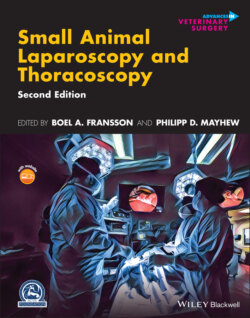Читать книгу Small Animal Laparoscopy and Thoracoscopy - Группа авторов - Страница 49
Needle Holders for Laparoscopic Suturing
ОглавлениеConventional laparoscopic needle holders differ from most other laparoscopic instruments in that they do not rotate around the axis of the instruments in order to provide stability. Articulating and rotating needle drivers have been introduced but have been criticized for creating imprecision in needle exit and for being more difficult to learn to use than conventional needle drivers [5].
The handles are often of a straight axial design, placing the needle in line with the surgeon's hands to allow greater maneuverability and more natural motion of the wrist when suturing. The jaws are often single action and are usually operated by means of an ergonomic spring‐loaded palm grip on the handle.
Several handle types are available, and the efficacies of four of them were compared. [6] It was found that a pistol grip (Figure 2.1) was superior for experienced operators but not for novices, who preferred a palmed straight grip. Neither experienced or novice users performed well nor preferred a thumb–ring finger grip (Figure 2.2) [6].
For novice laparoscopic surgeons, we recommend a needle driver that is sturdy, with straight handle, a ribbed grip, and a conveniently located needle release button on the grip (Figure 2.3). Hand size differs among surgeons; therefore, the preferred position of the release button may differ. When the release button is placed in the axis of the instrument, it can be used with either hand.
Needle driver jaws may be straight, curved left, or curved right (Figure 2.4). They can also be self-righting. Straight jaws are this author's (BAF) preference because they can be used in both left and right positions. The jaws are designed for a particular range of needle sizes, which is important to note before purchase. Self-righting needle drivers force the needle into a fixed position, usually at 90° angle to the instrument shaft. The limitations of self-righting needle drivers is that they should not be used to grasp the suture because they may damage or weaken the material. In addition, they reduce the surgeon's freedom to position the needle in different angles.
Figure 2.1 Pistol grip laparoscopic needle driver.
Source: © 2014 Photo courtesy of KARL STORZ GmbH & Co. KG.
Figure 2.2 Needle driver with handle designed for thumb–ring finger grip. These did not perform as well as other designs.
Source: © 2014 Photo courtesy of KARL STORZ GmbH & Co. KG.
Figure 2.3 For novice laparoscopic surgeons, we recommend needle drivers that are sturdy, with straight handles, ribbed grips, and conveniently located needle release buttons on the grips.
Source: © 2014 Photo courtesy of KARL STORZ GmbH & Co. KG.
Figure 2.4 Different configurations of needle driver jaws. From top to bottom: “parrot jaw” curved left, “flamingo jaw” curved right for a 6‐mm cannula, and “flamingo jaw” curved right for an 11‐mm cannula.
Source: © 2014 Photo courtesy of KARL STORZ GmbH & Co. KG.
